Client Invoicing: 7 Proven Tips to Get Paid Faster in 2025
Chasing missed client payments is stressful. We’ve compiled the 7 best actionable client invoicing tips to help you get paid on time.

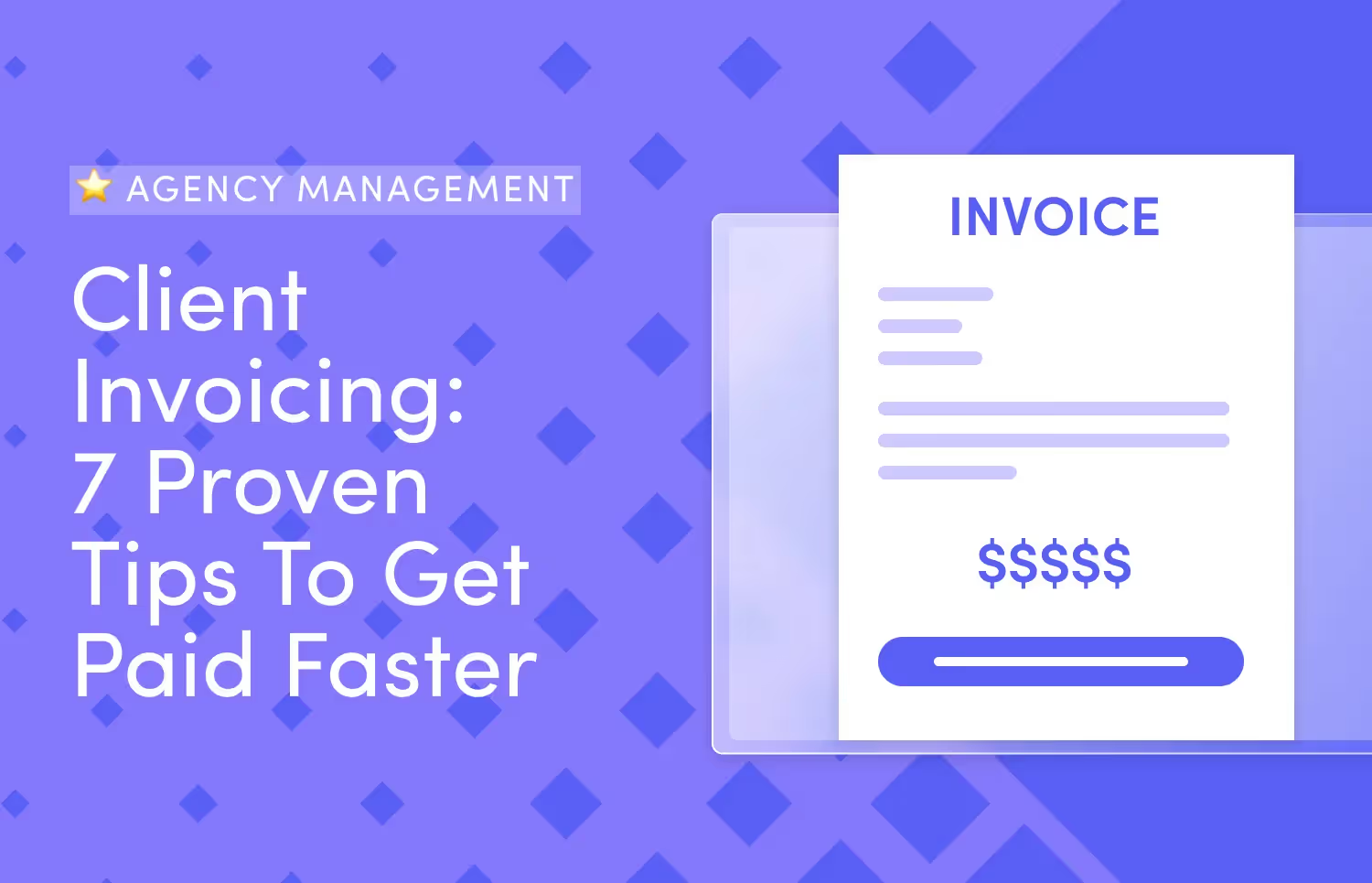


Nothing sends your anxiety to the roof faster than multiple past-due client invoices.
After all, who’d want to chase invoices? Dealing with multiple missed client payments can be pretty stressful. Like barely-getting-enough-sleep type of stress, with constant worries about clients ghosting you or issuing severely delayed payments.
We feel you. As someone who takes pride in your agency’s work, the last thing you want is to completely miss payroll because of clients who can’t pay on time.
This is why we’ve compiled the best actionable invoicing tips from agency owners who went through the horrors and returned wiser.
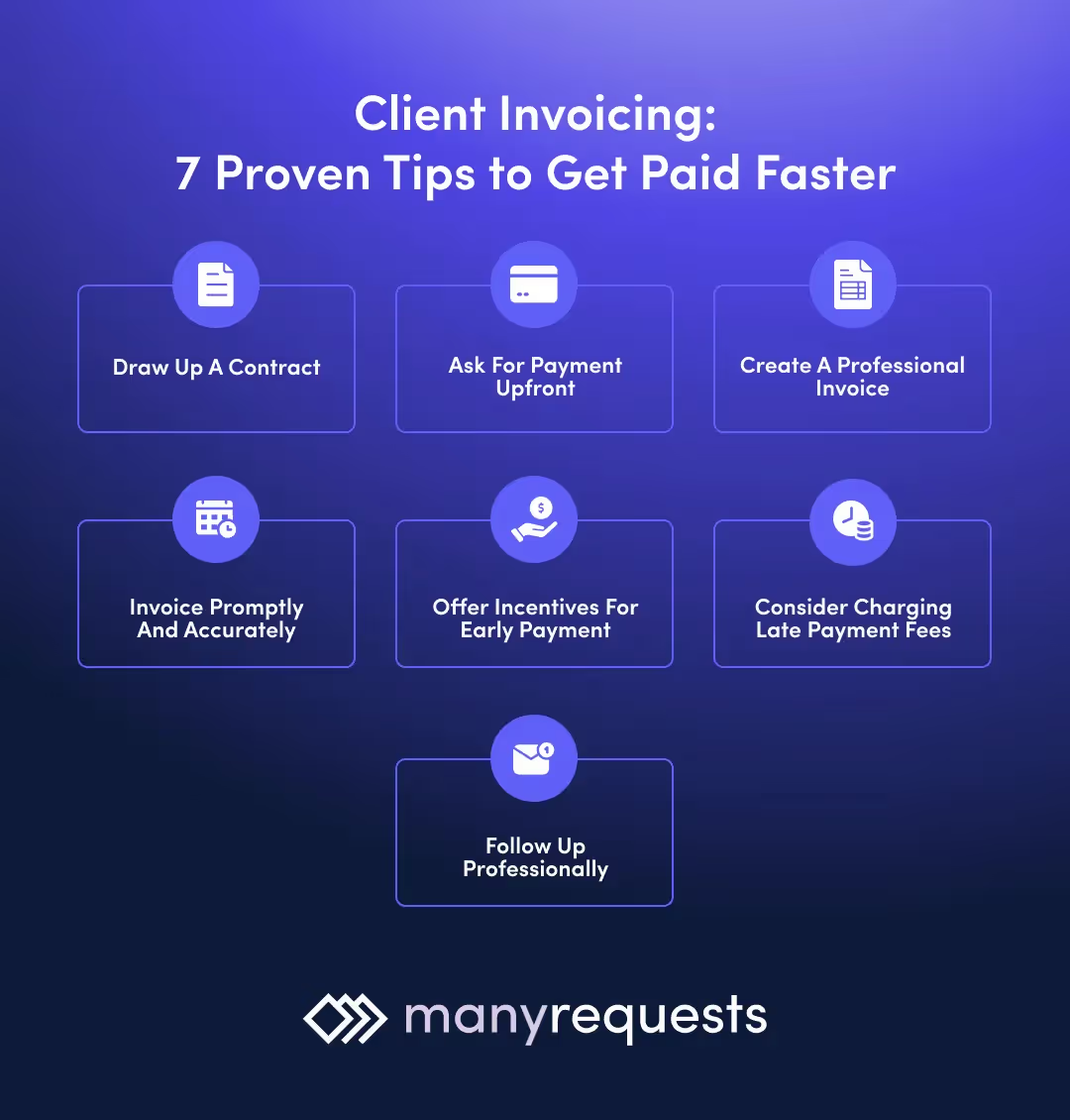
Whether you’re issuing an invoice for the first time or streamlining your process after dealing with late payments recently, this guide is for you.
You’ll learn tried-and-tested strategies from industry veterans so you can focus on delivering excellent outputs without getting bogged down by unpaid invoices.
But first, let’s talk about the basics…
An invoice is a document detailing the services rendered and the terms of payment the client must follow. It represents the money that should come in for creative agencies; without this cash flow, the business will be in big trouble.
Sadly, agencies are rife with horror stories involving delayed client payments. A 2022 Late Payments Report reveals design agencies often have to contend with this inconvenience, with 50% of their invoices getting paid up to 60 days (or more) too late.
Dealing with late payments means agencies must spend up to 13 hours per week following up, stealing precious time they could have spent sharpening their sales strategies, training new hires, finding new clients, or raising investments.
Which brings us to these golden rules on client invoicing (and getting paid on time):
Sending an invoice is one thing, but it takes excellent planning to ensure your clients won’t make any excuse to delay payment for as long as they want.
Here are seven tips you can apply right away to get your invoices paid on time and safeguard your agency’s finances:
Letting your clients dictate when you’ll get paid immediately puts you on a losing end.
A contract ensures a win-win situation for both parties before the project officially begins.
A well-structured contract sets the foundation for your business relationship and protects you from potential payment delays and disputes.
Negotiations can happen before a contract is finalized. Once it’s signed, however, every communication after that will simply reinforce what’s already in the document.
Here's how you can create a contract that covers all your bases:
Scope creep happens when the project requirements exceed the original project scope. Here’s how your agency can deal with it:
Upfront payments are built on trust, but the scale is tipped in your favor this time.
This type of advanced payment requires clients to pay the invoice before the project starts.
Charging clients upfront secures the agency’s cash flow and ensures clients are committed to the project.
Here’s how to implement an upfront payment process that works:
While most clients should adhere to your upfront payment terms, enterprise and government clients may require different arrangements, such as net 30 or net 90 payment terms. These clients are usually reliable, but setting expectations and monitoring payments closely is important.
Details of the upfront payment must be included in the contract you created earlier.
Discuss it with the client before the contract signing to establish transparency and ensure both parties are on board with the payment setup.
Setting upfront payments creates a strong foundation for a healthy client relationship and protects your business from potential cash flow issues.
Once the terms and conditions of the contract are clear to both parties, you can whip up a professional-looking invoice to send to your client.
You can create your invoice from scratch or let one of those cloud-based invoicing software do the job for you.
Whatever you choose, the invoice should contain these basic details:
Doing this old-school invoicing may still work if you’re just a freelancer dealing with a few clients.
However, agency owners or managers with a lot on their plates may find the manual invoicing process time-consuming.
Not only is it tedious, but it also lacks the scalability agencies need to send and manage multiple client invoices at once.
Fortunately, ManyRequests’ all-in-one client portal software includes integrated invoicing, which helps agencies generate client invoices quickly.
This means agencies won’t have to spend an arm and a leg on multiple apps, as everything they need to run their business smoothly is under one roof.
The clients' experience is equally smoother, as they can easily make design requests, review the outputs, receive invoices, and complete payments from their self-service portal.
Let’s learn more about ManyRequests’ invoicing in the following section.
Here’s how ManyRequests can help solve your invoicing troubles and keep your agency’s finances on track:
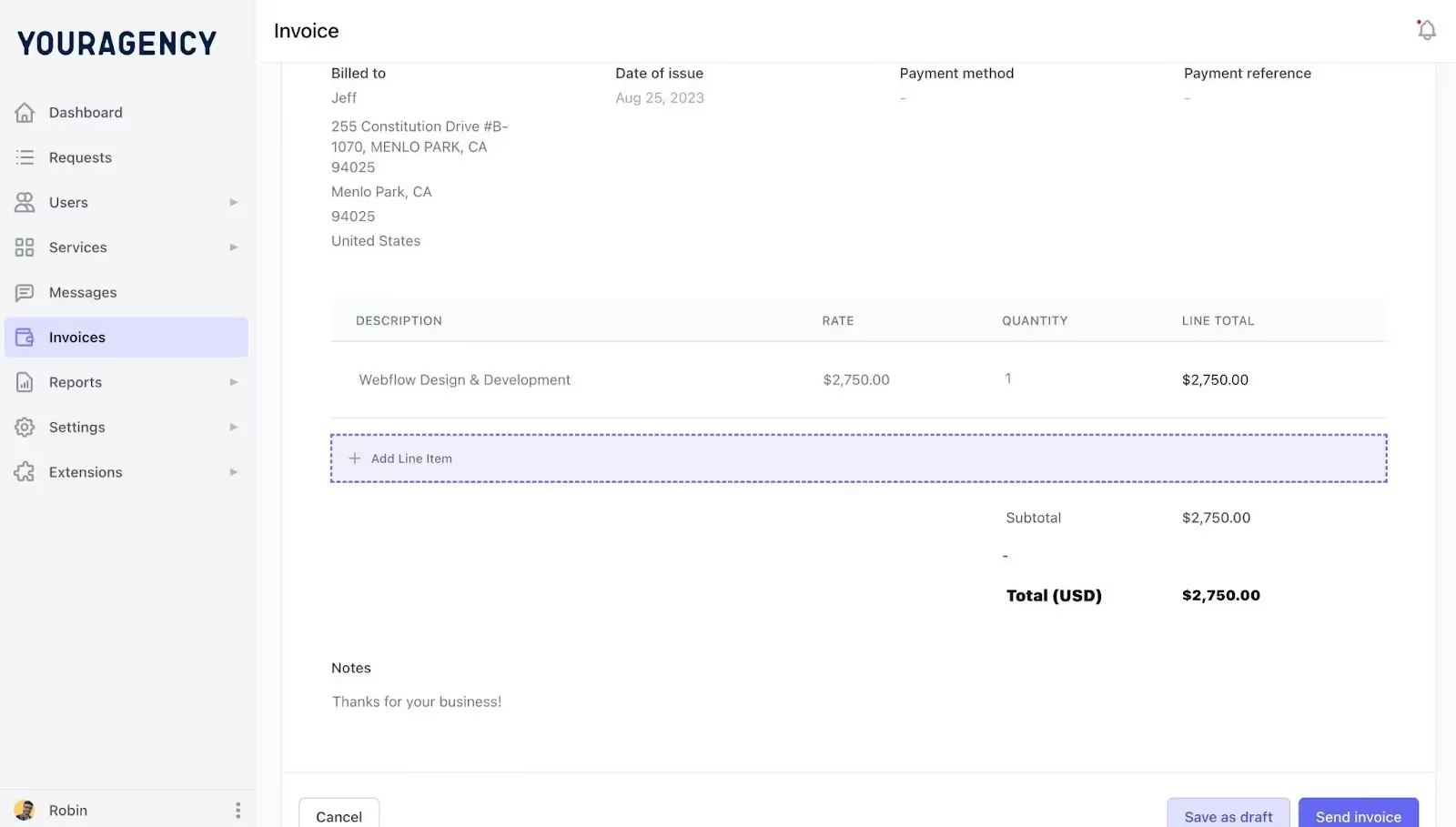
ManyRequests offers built-in tools that allow you to create invoices in a few clicks.
You can add all the necessary details—such as your business name, logo, contact information, client details, project name, and a breakdown of services—ensuring your invoices look professional and are easy to understand.
You can download the generated invoice with one click and send it to your client manually.
If you’re sending multiple client invoices, ManyRequests can simplify the entire process. You can create and send invoices directly through the platform or add them to the client portal, where clients can view and manage their payments.
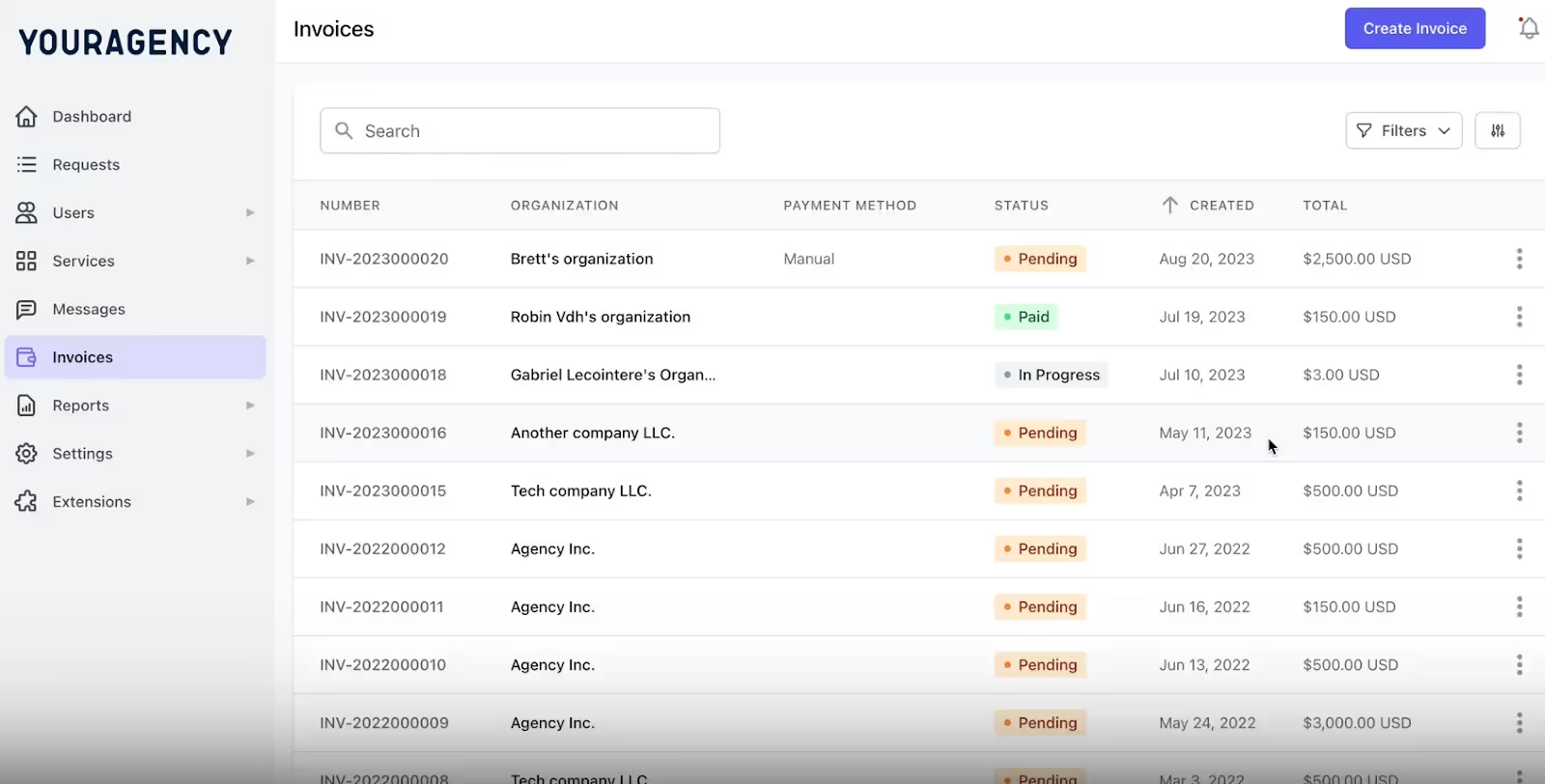
With ManyRequests, you can manage all your invoices in one centralized location. The platform provides a clear overview of your finances, including incoming payments and overdue invoices.
You can even impersonate clients to see what the invoice looks like from their perspective, ensuring clarity and transparency in every transaction. This comprehensive view helps you stay on top of your financials and reduces the likelihood of missed payments or overlooked invoices.
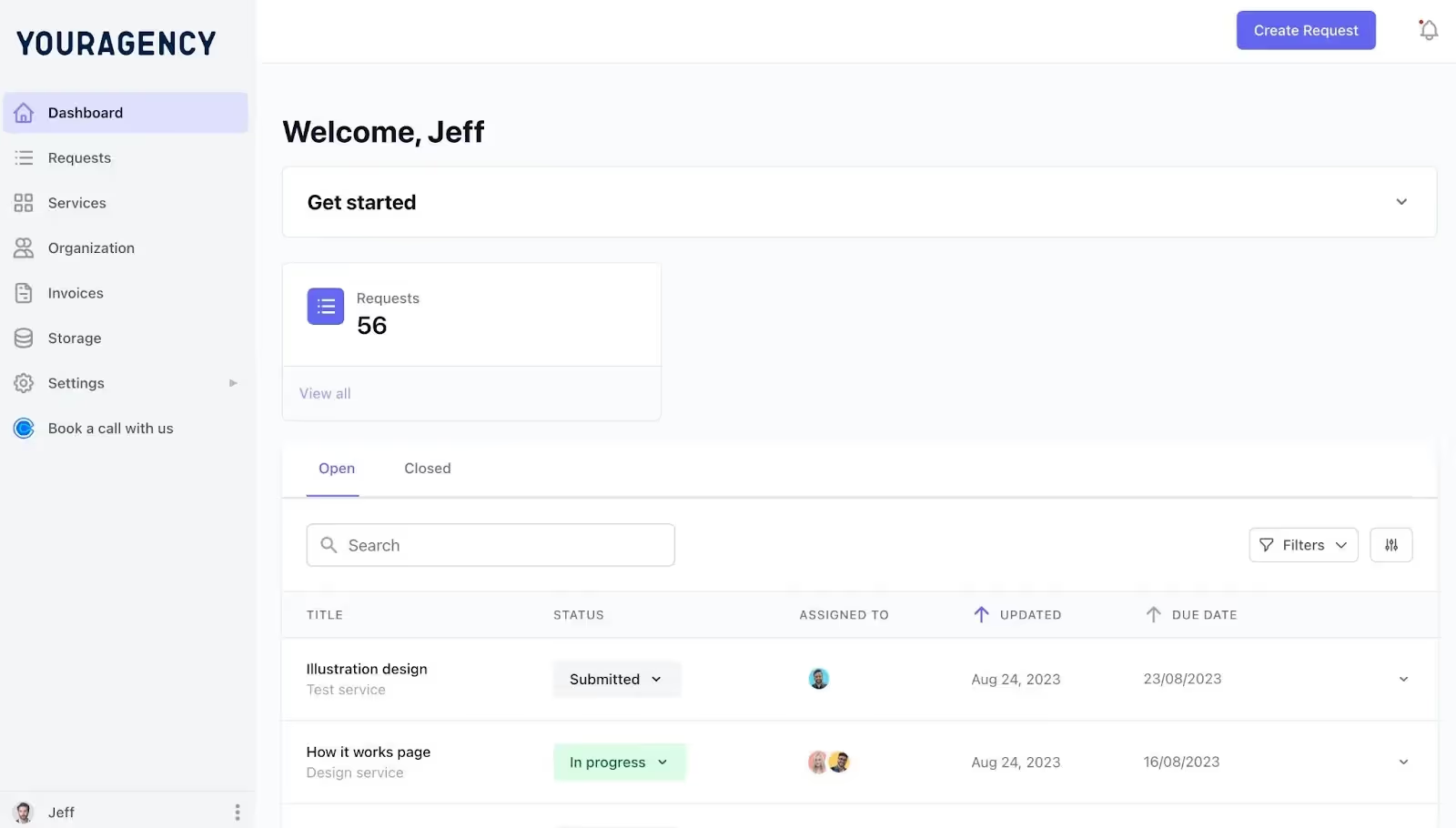
One of ManyRequests's standout features is the ability to create customized client portals. These portals give your clients a dedicated space to log in, view invoices, manage payments, and communicate with your team.
This feature reduces the need for back-and-forth emails, as everything related to billing and payments is accessible in one place. It’s a time-saver for you and your clients, ensuring smoother transactions and better communication.
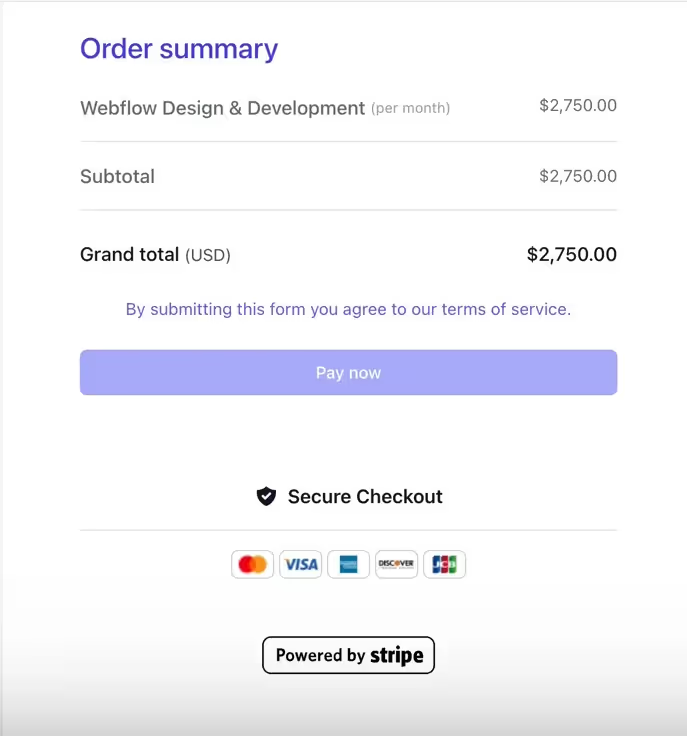
For agencies that need a reliable payment processing system, ManyRequests integrates seamlessly with Stripe.
This integration allows you to accept payments from major credit cards and manage all your subscriptions and invoices in one place.
Whether it’s a one-time payment or a recurring subscription, Stripe handles the payment process automatically, marking invoices as paid once the transaction is complete. This automation ensures you don’t have to update payment records, reducing the risk of errors and missed payments.

While automation is key, there are times when clients may need to pay via alternative methods such as bank transfers, checks, or other manual processes.
ManyRequests accommodates these situations by allowing you to manage manual payments within the platform. You can track these payments alongside your automated transactions, ensuring that all financial data is organized and easily accessible.
Automating your invoicing process with ManyRequests streamlines your workflow and significantly reduces the stress and time associated with managing payments.
In addition to the features above, ManyRequests can also help you:
By implementing ManyRequests, you can keep track of your invoices and ensure that your agency gets paid faster and more efficiently.
Discover how ManyRequests’ billing and invoicing features can improve your agency’s cash flow, or sign up for a free trial today to test if it’s the right fit for your business.
A streamlined and efficient invoicing process minimizes delays and helps maintain a positive cash flow for your agency.
Here’s how you can ensure your invoices are accurate and sent promptly:
Sending a preemptive email to inform your client that an invoice will be sent soon can help prepare them for the payment and reduce the likelihood of delays.
This pre-billing communication can prevent bill shock and ensure your client is ready to process the payment as soon as the invoice is received.
The faster you send out your invoices, the quicker you can expect payment.
Make it a habit to issue invoices when a project milestone is reached, or work is completed. This will keep your cash flow steady and ensure the transaction remains fresh in your client’s mind, reducing the likelihood of delays.
Accuracy is crucial in invoicing. Ensure that every invoice includes all the necessary details to avoid disputes and payment delays:
Disputes over invoices can slow down the payment process significantly. To avoid disputes:
Encouraging clients to pay their invoices on time can be challenging, but offering early payment incentives can be a powerful tool. Not only does it reward clients for settling their invoices quickly, but it also helps you recoup your money faster, improving your cash flow.
Here’s how you can implement early payment incentives effectively:
One of the most straightforward ways to encourage early payment is to offer a discount to clients who pay within a specific time frame.
For example, you could offer a 2% discount on invoices paid within seven days. This small percentage can encourage clients to prioritize your payment, especially if they’re managing multiple invoices from various service providers.
To further motivate early payments, consider implementing tiered discount levels based on how quickly the invoice is paid. For instance:
This structure encourages prompt payment and gives clients flexibility, making it more likely they’ll take advantage of the discount.
You may also selectively offer early payment discounts, especially to clients with a good payment history.
Segment your clients based on their payment data and offer discounts to those who consistently pay on time or benefit from a little extra motivation to pay promptly.
This approach helps you build stronger relationships with reliable clients while encouraging better payment habits from others.
You are not a bank, and your time is valuable. When clients delay payments, it’s only fair to impose penalties for the inconvenience caused.
An automated billing system can be set up to add late fees to all overdue invoices. This eliminates the need for manual follow-ups and reinforces the importance of timely payments.
By automating this process, you ensure consistency and fairness across all clients. Here's how you can put this into practice:
To avoid surprises, ensure your clients are fully aware of your late fee policy before receiving their first invoice.
Include a stipulation in your payment terms that clearly states the penalties for late payments. For example, specify that any invoice not paid within 30 days will incur a daily interest or a fixed late fee.
It’s also important to know the maximum interest levels you can charge in your state to ensure compliance with local laws.
To maintain goodwill, consider offering a one-time grace period for first-time offenders.
When a client misses a payment, you can politely remind them that your billing system will automatically add late fees to overdue invoices.
However, as a gesture of goodwill, you can offer to bypass this fee if they settle the payment by a specific date. This approach encourages prompt payment and shows you can be flexible when necessary.
Here’s a template you can use:
Subject: Overdue Invoice Reminder and Late Fee Notice
Hi [Client’s Name],
I hope you’re doing well. I wanted to remind you that invoice [Invoice Number] is now overdue. Per our payment terms, a late fee will automatically be applied to unpaid invoices. However, as a one-time courtesy, I can waive this fee if payment is received by [Specific Date].
Please let me know if you have any questions or concerns. I appreciate your prompt attention to this matter.
Best regards,
[Your Name]
[Your Position]
[Your Company Name]
Even with the best invoicing practices, there are times when payments can be delayed. When this happens, following up professionally to maintain a positive relationship while ensuring you get paid is crucial.
Here’s how you can approach this sensitive task:
If a payment is overdue, your first step should be to send a polite reminder. Depending on your client's preferred communication method, you can do this via email or instant messaging.
If you manage your clients through ManyRequests, this is handled through a built-in messaging system where all project-related communications are stored in one place. This way, you won’t have to deal with a scramble of emails each time you check for invoice updates.
The key is to remain professional and understanding—there could be various reasons for the delay, and showing empathy can go a long way in preserving the relationship.
Here’s a template you can use:
Subject: Friendly Reminder: Invoice [Invoice Number] Due
Hi [Client’s Name],
I hope you’re doing well. I wanted to check in regarding the invoice [Invoice Number] that was due on [Due Date]. If everything is in order, please provide an update on the payment status. This will help us keep everything on track.
Please contact us with any concerns or if you need to discuss the payment. We’re happy to work out an arrangement that suits both parties.
Thank you for your attention to this.
Best regards,
[Your Name]
[Your Position]
[Your Company Name]
This approach is polite yet firm. It clearly states that you expect payment while also offering to address any client's concerns.
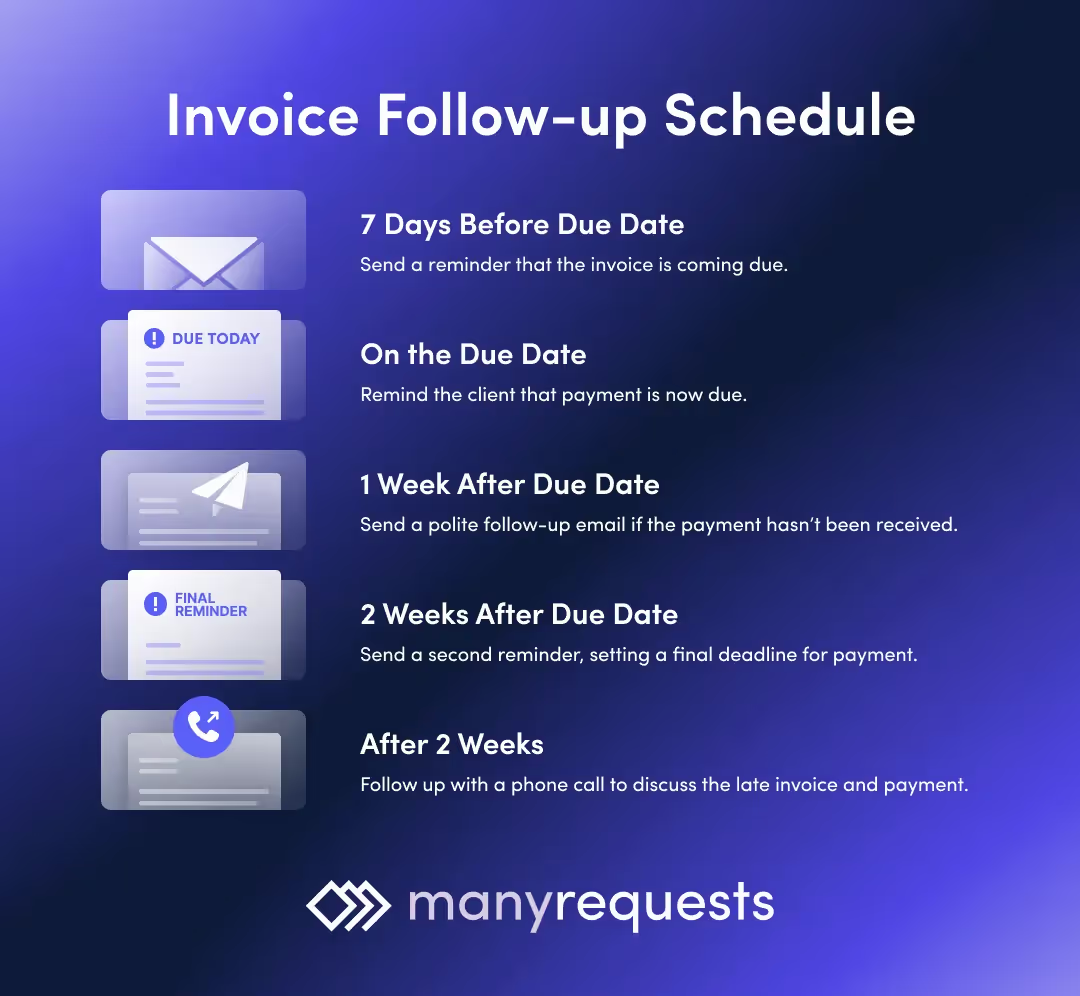
Consistency is key when following up on unpaid invoices. Set a clear follow-up schedule that you can stick to. Here’s a suggested timeline:
Throughout your follow-up process, it’s essential to remain professional and empathetic. Understand that late payments can be sensitive, and aggressive or confrontational behavior can damage your client relationship.
Maintain a positive attitude and emphasize that you’re open to finding a solution that works for both parties.
Sometimes, despite your best efforts, a client may consistently pay late or not respect your payment terms.
In such cases, it’s important to recognize when it’s time to part ways. If a client is causing more stress than they’re worth, it may be best to discontinue the relationship.
Your time and energy are valuable, and working with clients who respect your business practices will ultimately lead to a more successful agency.
Yes, you can invoice a client without a formal contract, but it's not the best practice.
While you can still request payment for work done, having a written agreement makes the process smoother and legally clearer. A contract helps outline the project's terms, payment details, and what happens if there's a disagreement, making it easier to enforce payment if issues arise.
The best time to invoice your client is right after you’ve completed and delivered the work.
Sending the invoice promptly keeps the payment fresh in your client's mind, making it more likely that you'll get paid quickly.
Although it might feel pushy to invoice immediately, it’s a standard practice that clients expect. If your industry has different norms, like billing at the end of the month or after reaching certain milestones, discuss and agree on these terms with your client upfront.
Typically, payment is expected within 30 days of issuing the invoice, which is the standard in many industries. However, this can vary depending on what you and your client have agreed upon.
Creative industries operate on shorter payment windows, like 14 days, while others allow more extended periods. It’s essential to set a precise due date on your invoice and to communicate any late fees if the payment isn’t received on time.
If a client is late in paying an invoice, your first step should be to send a polite reminder. An email is usually sufficient to start, but if you don’t get a response, follow up with a phone call.
It’s important to stay professional and not let the situation drag on—being prompt and transparent in your communication shows that you take your payment terms seriously.
If late payments become recurring, consider discussing stricter terms or late fees with the client to avoid future problems.
For large payments, especially those that exceed the limits of services like Zelle, you’ll want to use more reliable methods like ACH transfers or paper checks. These methods are standard for significant sums and avoid the higher fees associated with credit card processors like Stripe.
For convenience and scalability, many agencies set up payment processors like Stripe or Bankcard USA, allowing them to handle small and large payments efficiently. This also enables auto-billing, saving time and reducing the hassle of chasing down payments.
Running a successful agency can be financially rewarding. However, it can also cause you to lose much sleep, especially if you’re constantly chasing invoices.
The article discussed above is packed with actionable tips on issuing invoices and ensuring they are converted to client payments.
While these tips may work for manual invoicing, agencies dealing with many clients are better off with automated tools.
For creative agencies looking for a comprehensive solution, ManyRequests is the best tool for managing invoicing and client communication. It enables you to send invoices in a few clicks, see the status of each invoice at a glance, receive payments from clients, and follow up on past-due invoices, all in the same place.
See how ManyRequests can help you simplify invoice creation and follow-up without the hassle of back-and-forth email exchanges. You can also sign up for its 14-day free trial and test its invoicing features at no cost.